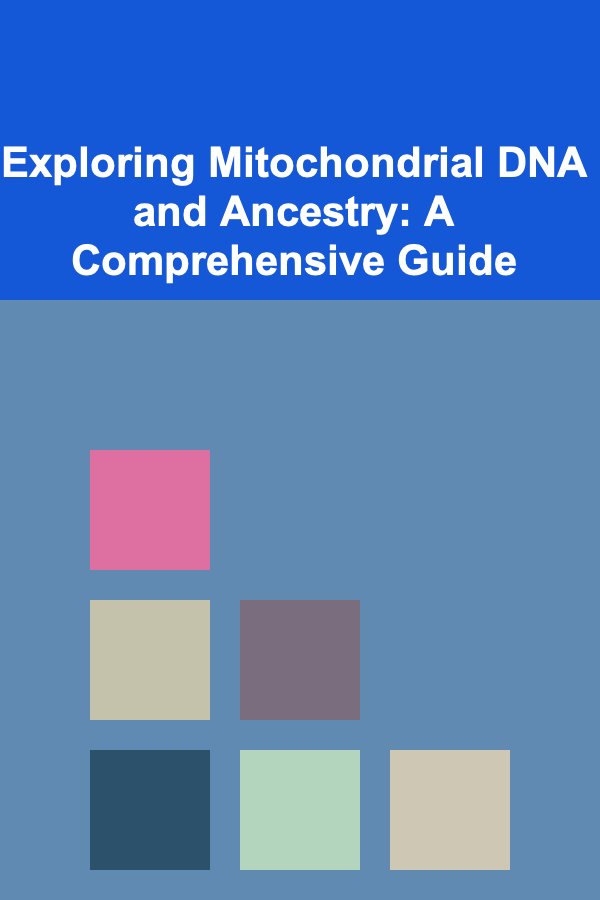
Exploring Mitochondrial DNA and Ancestry: A Comprehensive Guide
ebook include PDF & Audio bundle (Micro Guide)
$12.99$6.99
Limited Time Offer! Order within the next:

Introduction: Unveiling the Maternal Lineage
In the fascinating realm of genetics and genealogy, mitochondrial DNA (mtDNA) stands out as a unique and powerful tool for tracing ancestry, particularly along the maternal line. Unlike nuclear DNA, which is inherited from both parents and undergoes recombination, mtDNA is passed down almost unchanged from mother to offspring. This maternal inheritance pattern makes mtDNA a valuable marker for understanding the deep history of female lineages and their migrations across the globe. This article provides a comprehensive guide to understanding mtDNA, its significance in ancestry tracing, the process of testing, interpreting results, and the limitations you might encounter.
While autosomal DNA reveals a blended heritage from all ancestors, and Y-DNA (for males) traces the paternal line, mtDNA offers a focused lens through which to examine the journey of your maternal ancestors. This exploration can uncover ancestral origins, migration patterns, and connections to distant relatives, providing a richer understanding of your family history.
Understanding Mitochondrial DNA
Mitochondria are organelles found within the cells of eukaryotic organisms. Often described as the "powerhouses" of the cell, mitochondria are responsible for generating energy through cellular respiration. Each mitochondrion contains its own DNA, distinct from the nuclear DNA found in the cell's nucleus. This mitochondrial DNA is circular, containing approximately 16,569 base pairs.
Key Characteristics of mtDNA
- Maternal Inheritance: mtDNA is almost exclusively inherited from the mother. During fertilization, the sperm's mitochondria typically do not enter the egg, meaning the offspring inherits mtDNA only from the mother's egg cell.
- High Mutation Rate: Compared to nuclear DNA, mtDNA has a relatively high mutation rate. These mutations accumulate over generations, creating distinct variations that can be used to trace ancestral lineages.
- Non-Recombining: mtDNA does not undergo recombination (mixing of genetic material from both parents) during reproduction, which means it's passed down relatively unchanged from mother to daughter. This makes it a reliable marker for tracking maternal ancestry.
- Copy Number: Each cell contains hundreds or even thousands of mitochondria, each with multiple copies of mtDNA. This high copy number makes it easier to extract and analyze mtDNA from various samples, including ancient remains.
The Hypervariable Regions (HVR1 and HVR2)
Within the mtDNA genome, certain regions exhibit a higher degree of variability than others. These regions are known as hypervariable regions (HVRs), particularly HVR1 and HVR2. These are the regions most commonly targeted in mtDNA ancestry testing.
- HVR1: This region (also known as Control Region 1) is located between nucleotides 16024 and 16383. It exhibits significant variation between individuals and is often used for basic mtDNA haplogroup assignment.
- HVR2: This region (also known as Control Region 2) is located between nucleotides 57 and 372. Like HVR1, it contains numerous polymorphic sites and helps refine haplogroup assignments.
- Coding Region: While HVR1 and HVR2 are the primary targets, some advanced tests also analyze the coding region of the mtDNA. This provides even greater resolution and can identify rare or specific haplogroups.
Mitochondrial Haplogroups: Defining Maternal Lineages
A mitochondrial haplogroup is a group of individuals who share a common ancestor along their direct maternal line. These haplogroups are defined by specific sets of mutations (single nucleotide polymorphisms or SNPs) in their mtDNA. Each haplogroup represents a distinct branch on the human family tree, tracing back to a common maternal ancestor.
Global Distribution of Haplogroups
Over time, human populations migrated and dispersed across the globe, carrying their distinct mtDNA haplogroups with them. Consequently, certain haplogroups are more common in specific geographic regions. For example:
- Haplogroups H, V, T, U, K, J, I, W, and X: These are the most common haplogroups in Europe. Haplogroup H, in particular, is the most prevalent, representing a significant portion of the European population.
- Haplogroups A, B, C, D, and X: These are the primary haplogroups found in indigenous populations of the Americas. They are believed to have originated in Asia and migrated across the Bering Strait thousands of years ago.
- Haplogroups L0, L1, L2, L3, L4, L5, and L6: These haplogroups are primarily found in Africa and represent some of the oldest lineages of modern humans.
- Haplogroups M, C, D, E, F, G, and Z: These are commonly found in Asia, reflecting the diverse genetic history of the continent.
Understanding Haplogroup Nomenclature
Haplogroups are designated using a hierarchical naming system. The major haplogroups are assigned letters (e.g., A, B, H, L), and further subdivisions are indicated by numbers and additional letters. For example, H1, H5a, and T2b are all subgroups of the larger haplogroups H and T, respectively. These finer distinctions within haplogroups can provide more specific information about your ancestral origins and connections to other individuals within the same lineage. Understanding this nomenclature helps in interpreting the nuances of your mtDNA results.
The Process of mtDNA Ancestry Testing
mtDNA ancestry testing has become increasingly accessible, with several companies offering direct-to-consumer (DTC) testing services. Here's a step-by-step overview of the process:
1. Choosing a Testing Company
Several companies offer mtDNA ancestry testing. Some popular options include:
- 23andMe: Provides basic mtDNA haplogroup assignment as part of their broader ancestry testing service.
- Family Tree DNA (FTDNA): Offers dedicated mtDNA testing options, including HVR1 and HVR2 sequencing, as well as full mitochondrial sequence testing. FTDNA has a large mtDNA database, which increases your chances of finding matches.
- MyHeritage DNA: Provides mtDNA haplogroup information as part of their overall DNA testing service.
When choosing a company, consider the following factors:
- Testing Coverage: Does the test sequence only the hypervariable regions (HVR1 and HVR2), or does it include the full mitochondrial genome? Full sequence testing provides more detailed information and can identify rare haplogroups.
- Database Size: A larger database increases the likelihood of finding matches with other individuals who share your mtDNA haplogroup.
- Price: Compare the costs of different testing options, including initial testing fees and any subscription fees for accessing advanced features or databases.
- Privacy Policies: Review the company's privacy policies to understand how your data will be stored, used, and shared.
2. Ordering and Receiving the Testing Kit
Once you've chosen a testing company, you'll order a testing kit from their website. The kit typically includes:
- Instructions: Clear instructions on how to collect your DNA sample.
- Collection Device: Usually a cheek swab (buccal swab) or a saliva collection tube.
- Return Packaging: A pre-addressed envelope or box for returning your sample to the lab.
3. Collecting Your DNA Sample
Carefully follow the instructions provided in the testing kit to collect your DNA sample. For a cheek swab, you'll typically rub the swab inside your cheek for a specified period of time. For a saliva sample, you'll spit into the collection tube until it reaches the designated fill line. It's crucial to avoid eating, drinking, or smoking for at least 30 minutes before collecting your sample to prevent contamination.
4. Shipping Your Sample to the Lab
Once you've collected your sample, seal it properly and return it to the lab using the provided packaging. Make sure to register your kit online with the testing company, as this is essential for linking your sample to your account and receiving your results.
5. DNA Analysis and Result Generation
Upon receiving your sample, the lab will extract the mtDNA and sequence the relevant regions (HVR1, HVR2, and possibly the coding region). The resulting DNA sequence is then compared to a reference sequence to identify any mutations (SNPs). These mutations are used to determine your mtDNA haplogroup assignment.
6. Receiving and Interpreting Your Results
After several weeks (the turnaround time varies depending on the testing company), you'll receive your mtDNA results, typically through an online account. The results will usually include:
- Your mtDNA Haplogroup: The main result, indicating your maternal lineage.
- Haplogroup Description: Information about the geographic origins and migration patterns associated with your haplogroup.
- Matching Individuals: A list of other individuals in the company's database who share your mtDNA haplogroup or have very similar mtDNA sequences. This can help you connect with distant relatives.
- mtDNA Sequence (Optional): Some companies may provide your complete mtDNA sequence, allowing for more in-depth analysis and comparison with other databases.
Interpreting your results involves understanding the meaning of your haplogroup and its historical context. Research your haplogroup online to learn more about its origins, migration patterns, and associated populations. Consider joining online forums or communities dedicated to mtDNA research, where you can connect with other individuals who share your haplogroup and learn from their experiences.
Interpreting Your mtDNA Results: A Deeper Dive
Understanding Haplogroup Origins and Migration Patterns
Once you know your mtDNA haplogroup, you can delve into its origins and migration patterns. Each haplogroup has a geographical origin, representing the location where the founder of that lineage lived. As populations migrated, they carried their mtDNA haplogroups with them, spreading them across different regions. By researching your haplogroup, you can gain insights into the potential migratory routes of your maternal ancestors.
For example, if your haplogroup is H, you can learn about its origins in the Near East and its subsequent spread throughout Europe. Understanding the migration routes associated with your haplogroup can provide clues about the potential regions where your maternal ancestors lived in the past.
Analyzing Matches: Connecting with Distant Relatives
mtDNA testing can also help you connect with distant relatives who share your maternal lineage. Most testing companies provide a list of individuals in their database who have a close match to your mtDNA sequence. The closer the match, the more recent the common ancestor.
However, because mtDNA mutates slowly, matches can represent relationships that go back many generations. It's important to consider the level of detail provided by the testing company. A full mtDNA sequence match is much more informative than a match based solely on HVR1, for example.
Contacting your mtDNA matches can be a valuable way to collaborate on genealogical research and learn more about your shared ancestry. You can exchange information about your family trees, compare ancestral locations, and potentially identify common ancestors.
Using mtDNA Data in Conjunction with Other Genealogical Records
mtDNA testing is most effective when used in conjunction with other genealogical records, such as birth certificates, marriage licenses, census records, and historical documents. mtDNA provides information about your direct maternal line, while these records can help you build out your family tree and connect the dots between your ancestors.
For example, you might use mtDNA testing to confirm the maternal lineage of a particular ancestor, and then use genealogical records to trace that ancestor's family back through time. Combining genetic and documentary evidence can provide a more complete and accurate picture of your family history.
Limitations and Considerations of mtDNA Testing
While mtDNA testing is a valuable tool for ancestry tracing, it's important to be aware of its limitations:
Focus on the Maternal Lineage Only
mtDNA only provides information about your direct maternal line, tracing back through your mother, grandmother, great-grandmother, and so on. It does not reveal anything about your paternal lineage or the lineages of other ancestors. For a more comprehensive view of your ancestry, you'll need to consider autosomal DNA testing and, for males, Y-DNA testing.
Limited Resolution for Recent Ancestry
Due to the slow mutation rate of mtDNA, it can be challenging to trace ancestry within the last few generations. Matches often represent relationships that go back many generations, making it difficult to pinpoint specific ancestors or connect with close relatives. Autosomal DNA testing is better suited for tracing recent ancestry.
Geographic Generalizations
While certain haplogroups are more common in specific geographic regions, it's important to avoid making sweeping generalizations about your ancestral origins based solely on your haplogroup. Human populations have migrated and intermixed throughout history, meaning that individuals from different regions can share the same haplogroup. Always use mtDNA data in conjunction with other evidence to draw more accurate conclusions.
Adoption and Uncertain Paternity
If you are adopted, or if there is uncertainty about paternity in your family tree, mtDNA testing can be particularly helpful in identifying your maternal lineage and connecting you with biological relatives. However, it's important to approach the process with sensitivity and be prepared for potentially unexpected results.
Database Bias
The accuracy of your mtDNA matches depends on the size and composition of the testing company's database. If the database is heavily skewed towards certain populations, you may be less likely to find matches if your maternal ancestors come from a different region. Consider testing with multiple companies to increase your chances of finding matches across different databases.
Ethical Considerations
Before undertaking mtDNA testing, consider the potential ethical implications. Are you prepared to learn potentially unexpected information about your family history? Have you discussed the possibility of testing with your relatives and obtained their consent? It's important to approach genetic genealogy with respect for privacy and sensitivity to the potential impact on family relationships.
Beyond Basic Testing: Advanced mtDNA Analysis
While basic mtDNA testing focuses on HVR1 and HVR2 sequencing to determine your haplogroup, more advanced options are available for those who want a deeper understanding of their maternal lineage.
Full Mitochondrial Sequence Testing
Full mitochondrial sequence testing involves sequencing the entire mtDNA genome, including the coding region. This provides a much more detailed picture of your mtDNA profile and can identify rare or specific mutations that are not detected by basic HVR1 and HVR2 testing. Full sequence testing can refine your haplogroup assignment and potentially connect you with more closely related individuals.
Phylogenetic Analysis
Phylogenetic analysis involves comparing your mtDNA sequence to a database of known mtDNA sequences and constructing a phylogenetic tree. This tree shows the evolutionary relationships between different mtDNA lineages and can help you understand how your haplogroup fits into the broader human family tree.
Ancient DNA Analysis
Ancient DNA analysis involves extracting and analyzing mtDNA from ancient remains, such as skeletal remains or mummified tissues. This can provide valuable insights into the genetic history of past populations and help trace the origins and migrations of human lineages over thousands of years. Comparing your mtDNA to ancient DNA samples can potentially reveal connections to specific historical populations or individuals.
Third-Party Analysis Tools
After receiving your raw mtDNA data from a testing company, you can use third-party analysis tools to further explore your results. These tools can help you identify specific mutations, compare your mtDNA sequence to reference sequences, and visualize your mtDNA profile. Some popular third-party tools include:
- MITOMAP: A comprehensive database of human mtDNA variations.
- HaploGrep: A tool for assigning mtDNA haplogroups based on your sequence data.
- mtDNA tree: A visual representation of the human mtDNA phylogenetic tree.
Conclusion: A Window into Your Maternal Past
Exploring mitochondrial DNA and ancestry offers a fascinating journey into your maternal past. By understanding the unique characteristics of mtDNA, the process of testing, and the interpretation of results, you can unlock valuable insights into your ancestral origins, migration patterns, and connections to distant relatives. While mtDNA testing has its limitations, when used in conjunction with other genealogical resources and a critical understanding of its scope, it provides a powerful tool for enriching your understanding of your family history and the broader human story. Remember to approach your exploration with curiosity, respect, and a willingness to learn, and you'll be rewarded with a deeper appreciation of your maternal heritage.
Reading More From Our Other Websites
- [Home Renovating 101] How to Create a Modern Look in Your Home Renovation
- [Personal Care Tips 101] How to Choose a Body Lotion for Oily Skin
- [Home Lighting 101] How to Use Lighting to Create a Relaxing Bathroom Ambience
- [Toy Making Tip 101] The Science of Play: What Making Your Own Toys Teaches About Engineering
- [Personal Financial Planning 101] How to Manage Your Personal Finances Like a Financial Planning Expert
- [Home Security 101] How to Secure Your Home Without a Security System
- [Home Soundproofing 101] How to Estimate the Cost of Home Soundproofing
- [Home Holiday Decoration 101] How to Create a Minimalist Holiday Decorations Setup That Still Feels Festive
- [Home Budget Decorating 101] How to Organize and Decorate Your Closet Like a Pro
- [Home Cleaning 101] How to Keep Your Home Smelling Fresh with Simple DIY Tricks

How to Create a Motivation Board for Your Fitness Goals
Read More
How to Create an Acoustic-Friendly Environment
Read More
How to Navigate the Bustling Markets of Marrakech
Read More
How to Appreciate the Melodies of Baroque Music
Read More
How to Grocery Shop for Meal Prep: A Checklist for Efficiency
Read More
How to Build a Georgian Style Dollhouse
Read MoreOther Products

How to Create a Motivation Board for Your Fitness Goals
Read More
How to Create an Acoustic-Friendly Environment
Read More
How to Navigate the Bustling Markets of Marrakech
Read More
How to Appreciate the Melodies of Baroque Music
Read More
How to Grocery Shop for Meal Prep: A Checklist for Efficiency
Read More